
The content of the article
- Flowers of hyacinths - varieties: water, eastern, mouse muscari, leguminous, wild
- Giacintic plant: legends and beliefs
- Hyacinths: landing, care and growing in a pot in room conditions
- Hyacinths: landing, care and cultivation from the bulb in the garden in open ground
- Planting hyacinths in spring and autumn
- Hyacinth: How often to water in a pot and in the garden?
- When hyacinths rush, when they bloom, how many times they bloom?
- Hyacinths have faded: what to do with them next?
- When to dig hyacinths after flowering, what to do with the bulb, how to store?
- Do I need to dig hyacinths every year?
- When to transplant hyacinths after flowering and after purchase?
- Hyacinth propagation: onion, seeds, leaves
- How to grow hyacinth from seeds, what do seeds look like?
- Why don't hyacinths bloom or bloom badly?
- Hyacinths: diseases
- Is it possible to keep hyacinths in the bedroom?
- Water hyacinth for aquarium for water purification
- Video: How to grow hyacinths on open ground and at home?
Fans and professionals in plant growing unambiguously love hyacinths for the variety of their varieties, color colors, unpretentiousness in care and beneficial properties.
Flowers of hyacinths - varieties: water, eastern, mouse muscari, leguminous, wild
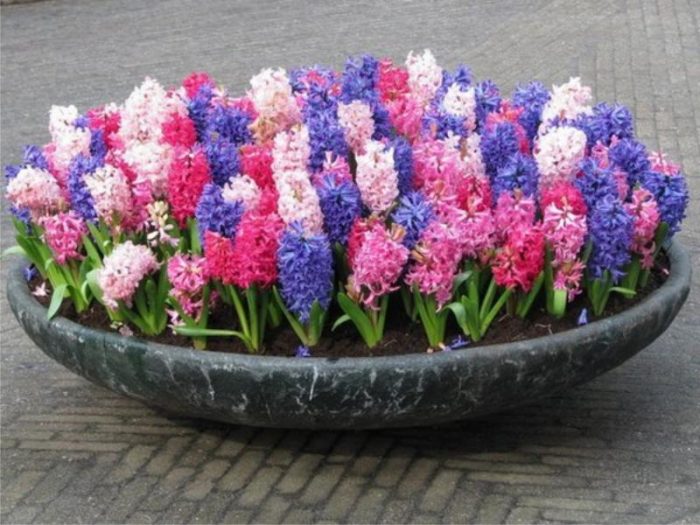
hyacinths of different colors in a large pot
Blooms with pink, purple and blue shades. The water hyacinth was widespread due to interesting properties to cleanse water from harmful microbes and pollution, to absorb harmful substances. It can be found in the reservoirs of our latitudes, as well as in aquariums.
Oriental hyacinth from Syria, Turkey, Libya. In the wild, it is found in pink, purple and milk. The flowering period of the plant is accompanied by a pleasant strong aroma.
- they look like barrels
- small
- densely and in large quantities are located on the peduncle
Bob, curly hyacinth is loved by gardeners who are fond of vine -like plants. In a number of African and Asian countries, its fruits are eaten, in all others - enjoy the beauty of leaves and flowers. The plant is annual, but easily takes root and grows.
Outwardly, wild hyacinth is a socket of continued leaves at the ends of the leaves and a stem with 4-10 flowers. Shades of colors are blue, purple, white. This type of hyacinths has no smell.
Giacintic plant: legends and beliefs

reproductions of pictures-stories on the origin of hyacinths
- about the beautiful young man of Hiakintos, at the site of the death of which this flower grew. Apollo was in love with the young man, but the jealous marshmallow, the god of western wind, was mortally wounded by Hiacintos during the training on the throwing of the disk. The name of the flower that appeared at the site of death was given by Apollo himself;
- about the wound of hyacinth. In an ancient Greek society, a man who bore this name was popular and revered. But over time, his fame faded, the god of beauty Apollo overshadowed him. Once they began to compete in the throwing of the disk. Apollo injured hyacinth and from the drops of the second blood falling to the ground sprouted scarlet hyacinths;
- about the appearance of flowers off the coast of Holland. After the crash of the vessel, a week later the children saw flowers and leaves swaying on the surfs along the coast. These were hyacinths;
- associated with the suicide of Ajax. After the death of Achilles Odysseus and Ajax, the rights to his weapons declared. The Council of Elders gave preferences to Odyssey. Ajax was amazed at their decision and pierced himself with a sword. Hyacinths grew in the place of his death.
Hyacinths: landing, care and growing in a pot in room conditions

hyacinths bloom in indoor pots
- For planting, choose large plants of the plant on the bulbs without damage and place them 1-3 pieces so that a gap of 2.5 cm remains around each.
- Pour drainage to the bottom of the pot, sand is suitable for these purposes. Then fill it with a mixture of sand with peat to the level of 2/3 of the bulb.
- Cover with a black cloth/paper and leave in a cool place for 1.5-2 months to ripen the peduncle and leaves in the bulb.
- Pour the bulbs regularly during the rest, but avoid flooding. Otherwise, they will begin to rot.
Depending on the variety of plants, you can please yourself with hyacinth flowers:
- early - at the end of December
- a little later - in late January - early February
- late-in March-April
In addition to choosing hyacinths in sandy soil, there is a method of growing in a vessel with water.
Hyacinths: landing, care and cultivation from the bulb in the garden in open ground
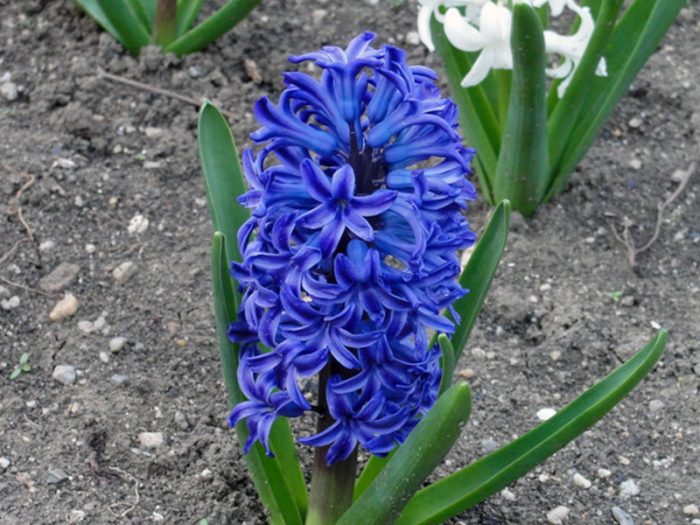
blue hyacinth grows on open ground
- add river sand or peat or three -year humus or old year's older leaves;
- the future corner with hyacinths is a calm place in which moisture does not stagnate. Its ideal location is between the bushes and/or trees, where the sun's rays pass well.
Dip them for half an hour in a fungicidal solution for disinfection.
Before the onset of cold weather, take care of covering the bulbs in order to protect against freezing. A thick layer of fallen leaves, peat or dry grass will help you save them.
On hot and/or dry days of autumn and spring, additionally water the bulbs, avoiding water from getting on them.
Planting hyacinths in spring and autumn
The best time to plant hyacinths on open ground is the end of September - the beginning of October. So the bulbs will have time to take root in front of the cold and gain strength before flowering next year.
In the spring, hyacinths are planted in open ground after their flowering in the pot so that they are nourished by natural substances.
Hyacinth: How often to water in a pot and in the garden?
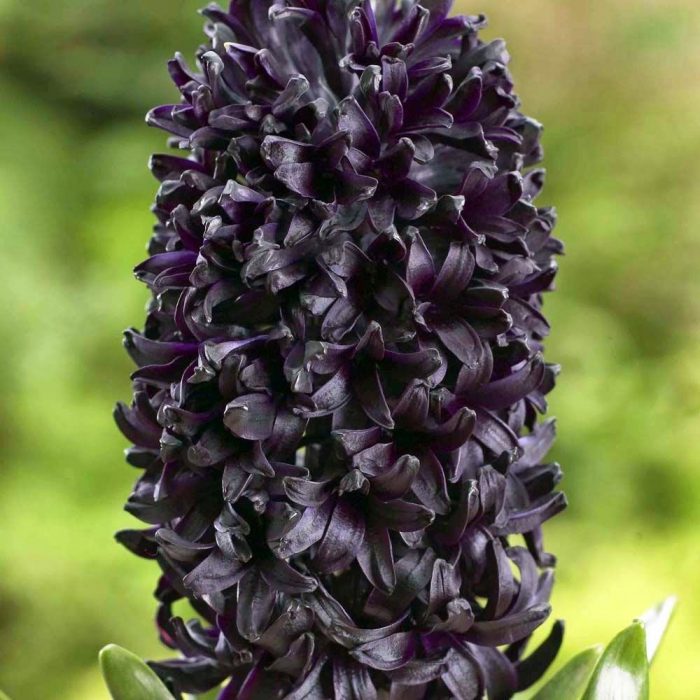
black hyacinth blooms thanks to good watering
When planting in a pot, the sand moisturizing the soil will become. Sprinkle it from above around the bulb and check after 3-4 days. Learn that during rooting, the hyacinth is in a cool room, so moisture will not evaporate quickly.
If you decide to dilute hyacinths in the garden, then immediately after landing into the ground, pour them abundantly.
When hyacinths rush, when they bloom, how many times they bloom?

blooming hyacinths of different shades
Plants living on open ground bloom in the spring with the advent of the first heat and rains. The end of March and the beginning of April is their months.
- end of December
- january-February
- the first spring months
Hyacinths have faded: what to do with them next?

the girl transplants hyacinths after flowering
Leave the plants for the next 2 months at rest so that they restore their vitality. The ideal option is not to touch the bulbs after flowering all summer.
- cut the wilted leaves and pedicels with scissors and transplant the bulb with the ground into a wide pot,
- dig on the bulbs after their ground part falls off, and put in the boxes in two layers. Leave them to dry in a cool room for a couple of months. Then change the temperature regime of their storage up to the cold,
- throw out the bulbs if there is no desire to mess with them further.
When to dig hyacinths after flowering, what to do with the bulb, how to store?

hyacinth bulbs are selected for storage
Dig on the bulbs with wilted leaves, without waiting for the second to disappear. Otherwise, the former will go deep into the ground and you simply will not find them.
- dry them with the ground for a week in a warm room, temperature +25 ℃;
- gently separate the earth from the bulbs and put the second into paper bags separately from each other or in two rows, if you have large boxes.
Transfer the boxes with bulbs to a cooler place with a temperature of up to +17 ℃ per month.
Do I need to dig hyacinths every year?
- the depth of their rooting
- flowering quality
- timely treat diseases
When to transplant hyacinths after flowering and after purchase?
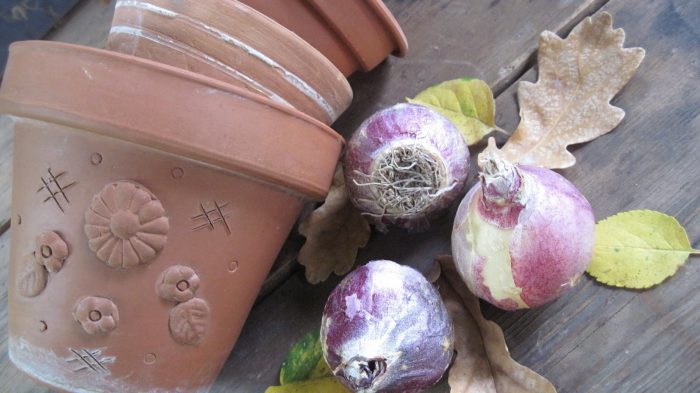
hyacinth bulbs ready for planting in pots
If you bought a plant in a pot, wait until the peduncle will wag and disappears. Then act either:
- pass the hyacinth into a pot of larger volume with new soil and drainage,
- fort it up a couple of times and at the time of wilting the leaves remove the bulb for drying and preparing for storage.
Hyacinth propagation: onion, seeds, leaves
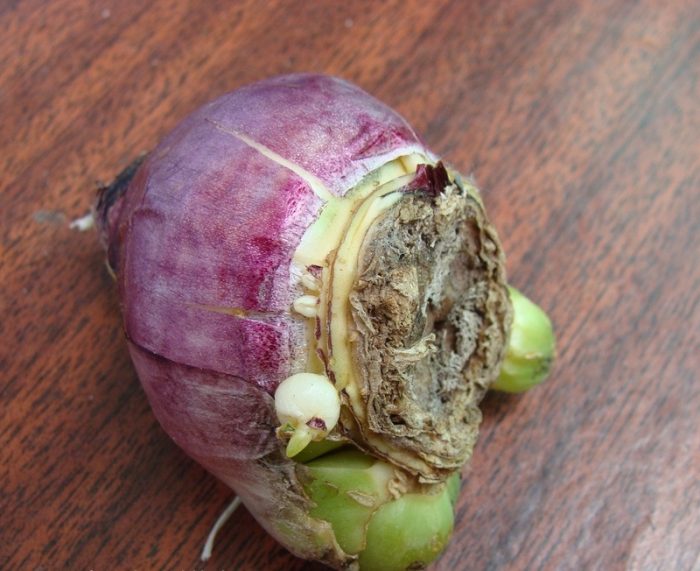
grown children on the mother's bulb of hyacinth
During flowering around an adult bulb, children form in an amount of 2-8 pieces. Select them and plant them separately, but they affect you with flowers only after 3-5 years.
Seed reproduction is used by breeders to create new varieties of hyacinths. The process of their cultivation is extremely painstaking and long. You will receive an adult flowering plant no earlier than 8 years.
How to grow hyacinth from seeds, what do seeds look like?
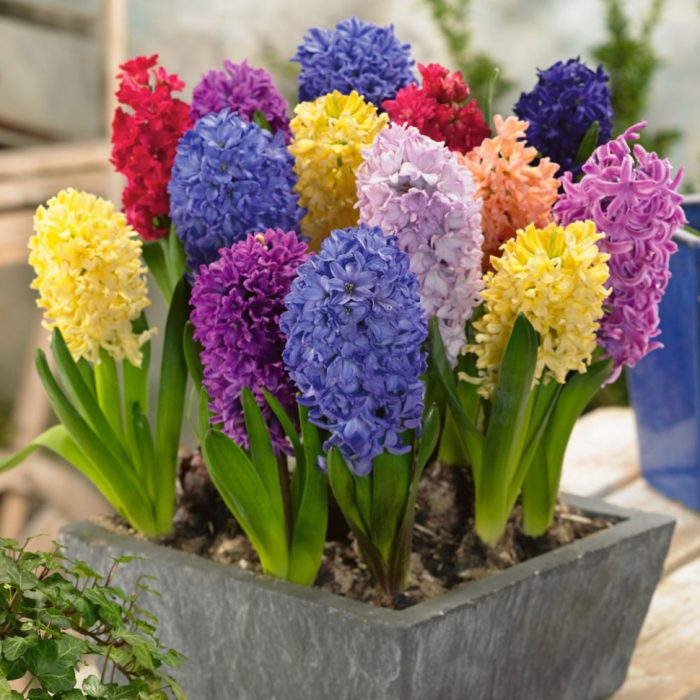
a variety of hyacinth colors is ensured by the reproduction of seeds
- Dry and remove the seeds.
- Lay them into paper bags and leave them stored in a moderately warm and wet room until the fall.
- Prepare the soil in the garden for landing - deliver, pour, pour sand to the bottom of the grooves.
- Drown the seeds densely into the grooves and fill them up. The best time for this is autumn.
- soil moisture and looseness
- its mineral composition
- lack of weeds
In autumn, plant only healthy specimens and repeat the care in the spring.
Why don't hyacinths bloom or bloom badly?
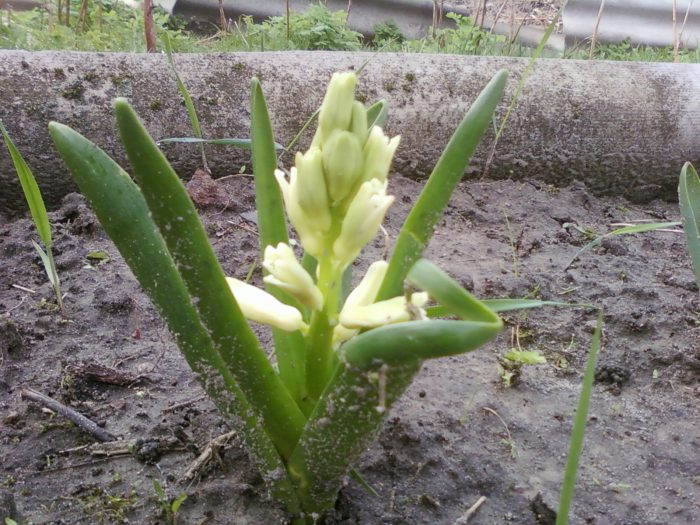
gyacinth with a short pedicel
- bulb. She could get into the soil already sick or with damage,
- storage. Namely, non -compliance with all the rules, poor -quality moisturizing air in the room,
- landing. Too early or late, to a greater or lower depth,
- priming. Excessively hard and dry or sour and humid, with weeds during planting and budding,
- incorrect selection of a place for landing. For example, the soil on which other bulbous plants grew last year is infected with diseases/pests, is dangerous for hyacinths,
- lack of watering and sunlight in the right amount.
Hyacinths: diseases

hyacinth is sick - it has yellow ends of the leaves
- physiological
- not physiological
- the curvature of the peduncle
- uneven opening of buds, when the top blooms the first
- the appearance of white buds
- green tops interspersed with blossomed flowers
- verkhushtnaya rot of an infectious nature
- donets and roots manifested during storage
- soft, or wet rot
Is it possible to keep hyacinths in the bedroom?

white hyacinth in the festive packaging on the windowsill
Yes, if you are not annoyed by its smell during flowering and in the bedroom there is a window with sunlight access in the afternoon.
Water hyacinth for aquarium for water purification
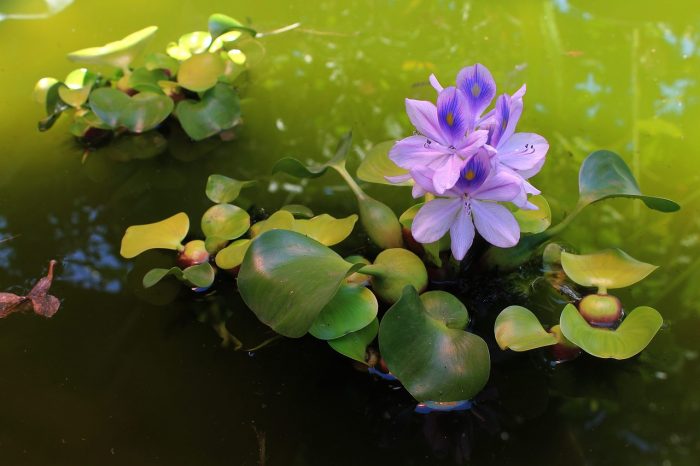
water hyacinth in the natural pond
- vase
- pond
- aquarium
Above the aquarium where Eichorni lives, be sure to install a lamp at an altitude of 40 cm so that the leaves get enough light.
So, we examined the features of growing hyacinths on open ground and in the pot, its beneficial properties for the purification of water bodies. We got acquainted with the process of propagation and care.
Buy this amazingly aromatic flower and make friends with it!
